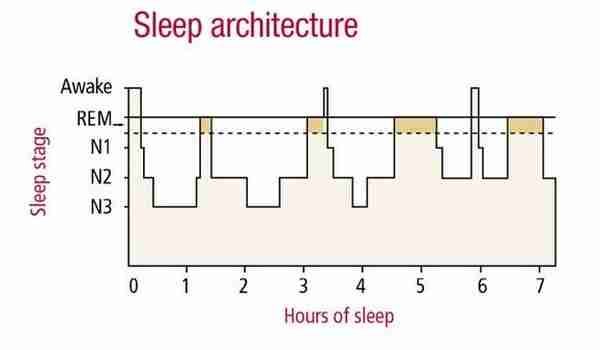Sleep plays a vital role in good health and well-being throughout your life. Getting enough quality sleep (see table) at the right times can help protect your mental health, physical health, quality of life, and safety.
The way you feel while you’re awake depends in part on what happens while you’re sleeping. During sleep, your body is working to support healthy brain function and maintain your physical health. In children and teens, sleep also helps support growth and development.
The damage from sleep deficiency can occur in an instant (such as an accident), or it can harm you over time by raising your risk for some chronic health problems or by affecting how well you think, react, work, learn, and get along with others.

Get More Sleep!
In this short talk, Arianna Huffington shares a small idea that can awaken much bigger ones: the power of a good night’s sleep.
Instead of bragging about our sleep deficits, she urges us to shut our eyes and see the big picture: We can sleep our way to increased productivity and happiness – and smarter decision-making.
The Stages Of Sleep
Quiet (non-REM) sleep
- In making the transition from wakefulness into light sleep, you spend about five minutes in stage N1 sleep. On the EEG, the predominant brain waves slow to four to seven cycles per second, a pattern called theta waves (see Figure 1). Body temperature begins to drop, muscles relax, and eyes often move slowly from side to side. People in stage N1 sleep lose awareness of their surroundings, but they are easily jarred awake. However, not everyone experiences stage N1 sleep in the same way: if awakened, one person might recall being drowsy, while another might describe having been asleep.
Read More
- This first stage of true sleep lasts 10 to 25 minutes. Your eyes are still, and your heart rate and breathing are slower than when awake. Your brain’s electrical activity is irregular. Large, slow waves intermingle with brief bursts of activity called sleep spindles, when brain waves speed up for roughly half a second or longer. Scientists believe that when spindles occur, the brain disconnects from outside sensory input and begins the process of memory consolidation (which involves organizing memories for long-term storage). The EEG tracings also show a pattern called a K-complex, which scientists think represents a sort of built-in vigilance system that keeps you poised to awaken if necessary. K-complexes can also be provoked by certain sounds or other external or internal stimuli. Whisper someone’s name during stage N2 sleep, and a K-complex will appear on the EEG. You spend about half the night in stage N2 sleep.
- Eventually, large, slow brain waves called delta waves become a major feature on the EEG, and you enter deep sleep. Breathing becomes more regular. Blood pressure falls, and the pulse slows to about 20% to 30% below the waking rate. The brain is less responsive to external stimuli, making it difficult to wake the sleeper.
Dreaming (REM) sleep
Dreaming occurs during REM (rapid eye movement) sleep, which has been described as an “active brain in a paralyzed body.” Your brain races, thinking and dreaming, as your eyes dart back and forth rapidly behind closed lids. Your body temperature rises. Your blood pressure increases, and your heart rate and breathing speed up to daytime levels. The sympathetic nervous system, which creates the fight-or-flight response, is twice as active as when you’re awake. Despite all this activity, your body hardly moves, except for intermittent twitches; muscles not needed for breathing or eye movement are quiet.
Read More
The role of REM sleep
Just as deep sleep restores your body, scientists believe that REM or dreaming sleep restores your mind, perhaps in part by helping clear out irrelevant information. Studies of students’ ability to solve a complex puzzle involving abstract shapes suggest the brain processes information overnight; students who got a good night’s sleep after seeing the puzzle fared much better than those asked to solve the puzzle immediately.
Earlier studies found that REM sleep facilitates learning and memory. People tested to measure how well they had learned a new task improved their scores after a night’s sleep. If they were subjected to periodic awakenings that prevented them from having REM sleep, the improvements were lost. By contrast, if they were awakened an equal number of times from deep sleep, the improvements in the scores were unaffected. These findings may help explain why students who stay up all night cramming for an examination generally retain less information than classmates who get some sleep.
About 3-5 times a night, or about every 90 minutes, you enter REM sleep
The first such episode usually lasts for only a few minutes, but REM time increases progressively over the course of the night. The final period of REM sleep may last a half-hour. If you’re deprived of REM sleep and then allowed a subsequent night of undisturbed sleep, you will enter this stage earlier and spend a higher proportion of sleep time in it—a phenomenon called REM rebound.
Sleep Architecture
During the night, a normal sleeper moves between different sleep stages in a fairly predictable pattern, alternating between REM and non-REM sleep. When these stages are charted on a diagram, called a hypnogram *), the different levels resemble a drawing of a city skyline. Sleep experts call this pattern sleep architecture.

In a young adult, normal sleep architecture usually consists of four or five alternating non-REM and REM periods. Most deep sleep occurs in the first half of the night. As the night progresses, periods of REM sleep get longer and alternate with stage N2 sleep. Later in life, the sleep skyline will change, with less stage N3 sleep, more stage N1 sleep, and more awakenings. Control of many of the features of sleep architecture resides in the brainstem, the area that also controls breathing, blood pressure, and heartbeat. Fluctuating activity in the nerve cells and the chemical messengers they produce seem to coordinate the timing of wakefulness, arousal, and the 90-minute changeover that occurs between REM and non-REM sleep.
A Good Night’s Sleep
The brain uses a quarter of the body’s entire energy supply, yet only accounts for about two percent of the body’s mass. So how does this unique organ receive and, perhaps more importantly, rid itself of vital nutrients?
New research by Jeff Iliff suggests it has to do with sleep.
Dream:ON – The App
Professor Richard Wiseman launched the Dream:ON App at the Edinburgh International Science Festival 2012. It is developed and maintained by YUZA, a mobile experience team based in London.
The app is powered by an engine which constantly monitors and adjusts the behaviour of Dream:ON and thereby optimising the experience for the user. When the user enters the rapid eye movement (REM) stage of sleep where dreaming is most common, the app delivers unique audio soundscapes which the subconscious is shown to respond to.
The App is also a social experiment: in the morning it presents you with a graph of your movement during the night, allows you to tag any of your friends who appeared in your dreams via Facebook and invites you to post a short description of your dream to their experimental ‘Dream Bank’. Creating the world’s largest dream experiment.
Sleep Deprivation and Economic Consequences
Sleep deprivation has emerged as a significant public health issue, exerting considerable economic influence that extends beyond individual well-being. Numerous studies have established a direct correlation between insufficient sleep and decreased productivity. According to the Centers for Disease Control and Prevention (CDC), insufficient sleep is linked to an estimated loss of more than $400 billion annually in the United States alone. This loss predominantly manifests in reduced workplace efficiency, with employees operating at diminished capacity when they have not had adequate rest.
Read More
Productivity is not the only economic factor affected by sleep deprivation; absenteeism also plays a vital role. The American Psychological Association reports that sleep-deprived individuals are more likely to call in sick due to health issues stemming from fatigue, leading to significant losses for employers. Occupations that demand high levels of concentration and alertness, such as those in healthcare, transportation, and emergency services, are particularly impacted. When employees in these sectors do not sleep tight, the potential for costly errors increases, potentially resulting in adverse outcomes for both individuals and the organizations they serve.
Moreover, sleep deprivation can contribute to elevated healthcare costs due to its direct association with chronic conditions such as obesity, diabetes, and cardiovascular diseases. A lack of sleep prompts unhealthy lifestyle choices, ultimately straining healthcare systems. The National Sleep Foundation indicates that inadequate sleep can increase the risk for mental health disorders, compounding the economic burden through increased healthcare treatment demands.
Industries like manufacturing and hospitality also report vulnerabilities related to sleep-related issues. In these environments, decreased alertness can lead to accidents, injuries, and reduced overall productivity, costing businesses significantly. Ultimately, addressing sleep deprivation comprehensively could lead to marked improvements in economic performance across various sectors, ensuring a healthier, more productive workforce.
Sleep Quality and Workforce Efficiency
Quality sleep is a vital component of employee well-being and directly impacts workforce efficiency. Research indicates that adequate rest not only enhances individual performance but also contributes to enhanced team productivity and organizational success. Companies that recognize this connection have begun investing in employee wellness programs, particularly those targeting sleep health. For instance, a well-known tech firm recently implemented a comprehensive initiative aimed at promoting better sleep among its employees. The program included educational workshops on sleep hygiene, flexible work hours to accommodate individualized sleep needs, and even the provision of quiet spaces for short rests during the day. The resulting outcome was a marked improvement in productivity levels and employee morale.
Read More
Furthermore, a notable study by the University of California demonstrated that companies with sleep-promoting interventions saw a significant reduction in errors and accidents in the workplace. Employees reported feeling more focused and engaged, which translated into better customer service and higher quality outputs. By enabling their workforce to achieve restorative sleep, these employers ensured not only personal benefits for their staff but also a pivotal boost to their overall economic performance.
On a broader scale, when a substantial portion of the workforce is well-rested, the ripple effects can lead to remarkable economic growth. Healthy sleep patterns have been linked to improved health outcomes, reducing the burden on healthcare systems and lowering absenteeism rates. This ultimately translates into cost savings and a more resilient economy. Employers seeking competitive advantages today must pay attention to the fundamental aspects of their employees’ health, highlighting sleep quality as a critical area for investment. As more organizations begin to adopt similar strategies, the connection between sleep quality and workforce efficiency will only grow stronger, reinforcing the necessity for sleep-centric workplace policies.
Strategies for Improving Sleep and Boosting the Economy
Enhancing the quality of sleep among individuals can have profound implications for overall economic growth. Various stakeholders, including individuals, employers, and policymakers, can implement specific strategies to promote better sleep hygiene and ultimately contribute to a more productive society.
For individuals, prioritizing sleep hygiene is key. This involves establishing a consistent sleep schedule, creating a restful sleep environment, and understanding the importance of wind-down periods before bedtime. Furthermore, the use of relaxation techniques, such as mindfulness or light stretching, can ease the path to restful slumber. By investing time in these practices, individuals can improve their mental acuity, emotional stability, and overall well-being, leading to enhanced productivity at work and in everyday activities.
Employers
Employers also play a crucial role in enhancing workforce health by introducing workplace initiatives aimed at promoting quality sleep. Companies can develop policies that encourage flexible work hours or the possibility of remote work, enabling employees to manage their work-life balance more effectively. Additionally, providing access to wellness programs that focus on stress management and sleep education can help employees recognize the importance of sleep health and its relationship to workplace performance. By investing in the well-being of employees, companies can improve morale, reduce absenteeism, and ultimately boost productivity.
Policymakers
Policymakers have a responsibility to champion public health campaigns focused on sleep education. Initiatives that raise awareness about the significance of sleep quality can help demystify common misconceptions and foster a culture that values rest. Integrating sleep health into community health programs and educational systems can result in a well-informed public, capable of making better lifestyle choices. The long-term economic benefits derived from a healthier population, characterized by improved cognitive function and productivity, underscore the vital importance of prioritizing sleep health in our daily lives.
Don’t we forget to keep in mind: Quality sleep boosts productivity and strengthens the economy.
What’s More

My Blog ( 84 )
Dependence (6) Fiction (7) Karma (7) Landmarks (7) Paramount (7) Spectrum (7) Spotlight (8) Take Off (7) Terra Shapes (7) Trepidation (7) Unique (7) Virtue (7)
Amazing Stuff (8) Beyond Known (9) Controversial (9) Digital World (10) Inequities (8) Innovative (9) Metaphysics (9) Our Society (9) Outer Space (10) Value Creation (10) Yearnings (9)












